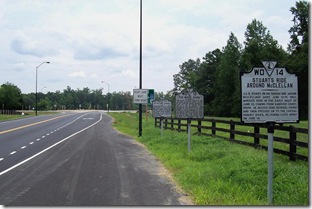 Marker No. WO-14
Marker No. WO-14
New Kent County, VA
Marker Text: J. E. B. Stuart, on his famous ride around McClellan's army, June 12-15, 1862, arrived here in the early night of June 13, coming from Hanover Courthouse. He rested here several hours and then pressed on to the Chickahominy River, rejoining Lee's army on June 15.
Location: On Route 249, just west of Route 106, Talleysville, grouped with markers WO-13 (St. Peter's Church) and WO-12 (The White House). Erected by the Conservation & Development Commission in 1931.
About the time J.E.B. Stuart had completed his ride around McClellan's Army and was reporting to Gen. Robert E. Lee, McClellan made his first report to Secretary of War Edwin Stanton:
“A rebel force of cavalry and artillery, variously estimated at from 1,000 to 5,000, came around our right flank last evening, attacked and drove in a picket guard...at Old Church; they proceeded to a landing 3 miles above White House, where they burned two forage schooners and destroyed some wagons. Then they struck the railroad at Tunstall’s Station, fired into a train of cars, killing some 5 or 6. Here they met a force of infantry which I sent down to meet them, when they ran off. I have several cavalry detachments out after them and hope to punish them. No damage has been done to the railroad.”
When Gen. Robert E. Lee became commander of the Army of Northern Virginia, he requested J.E.B. Stuart perform reconnaissance to determine whether the right flank of the Union army was vulnerable. Stuart set out with 1,200 troopers on the morning of June 12 and took his men on a complete circumnavigation of the Union army.
Early on the morning of June 13, 1862, J.E.B. Stuart revealed his orders to Fitz and Rooney Lee and the other commanders as they rode east towards Hanover Court House. Just west of the Hanover Courthouse, Stuart's advance guard ran into elements of the Union's 6th Cavalry, the first encounter with Union troops. Hoping to envelop the Union Cavalry, Stuart ordered Fitz Lee to strike the Union cavalry while Rooney Lee tried to flank the unit.
The Union commander in Hanover, Lt. Edward Leib formed a line along a ridge that Stuart's cavalry stuck hard, driving the Union cavalry off in disarray. At the nearby ford of the Totopotomoy Creek, Stuart was able to gain the information General Lee wanted. Lt. Leib realized the threat and withdrew down the Richmond Stage Road (today's U.S. Route 301). As the Union cavalry withdrew south towards Cold Harbor, Stuart did not pursue them. Having reconnoitered the area of interest to Lee, Stuart decided to continue his ride.
Photo taken looking east on Route 249 with intersection of Route 106 in background. Click any photo to enlarge.
Just before 3:00 p.m. Union Brigadier General Philip St. George Cooke, now aware that the Confederates were in force behind Union lines, ordered support for the cavalry that had been attacked. Cooke, who was Stuart's father-in-law, felt the Confederates might threaten his camp and began forming a strong line. He also brought up a brigade of infantry under G. K. Warren to assist in repelling an attack. Unfortunately, corps commander Fitz-John Porter ordered Cooke not to attack a superior force.
West of White House, (the home of Martha Washington) a massive Union supply depot existed. Stuart tried to capture at Tunstall's Station a train on the York River Railroad. With the first whistle, Stuart's men hastily constructed a wooden barricade across the track. When the engineer saw the obstacles on the track, rather than slow down the engineer poured on speed and smashed through the barricade. A cavalryman killed the engineer with his pistol, but the fireman took over, guiding the train towards White House. The train getting through put an end to the hope of raiding McClellan's main supply depot.
The above marker is located six miles southwest of the White House and the home of Martha Dandridge Curtis Washington. George Washington first met Martha at Poplar Grove, near by, in 1758. On January 6, 1759, Washington and Martha Curtis were married, it is believed at the White House or maybe at the St. Peter's Church, which is located two miles to the northeast of this marker. The White House was burned by Union troops when McClellan made the White House his base of operations in May, 1862. It is believed that the name for the President's home on Pennsylvania Avenue in Washington, D.C. is taken from this home of Martha's.

No comments:
Post a Comment